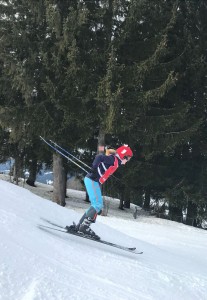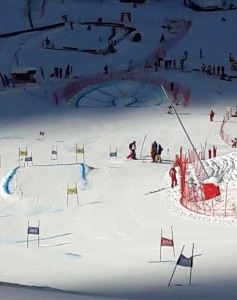Two Gold Medals!
5S Athlete Caroline has had huge success in the last few weeks and is at the FIS Masters races in Cortina this weekend!
At the British Telemark Championships this year the GS race was cancelled because of bad weather so we raced the Sprint and Classic. Both races have the same component parts – GS gates, a jump, a 360 degree banked loom and a skating section to the finish line, hence the use of long cross country ski poles to race with. The difference is that the Sprint is shorter so you ski two legs and the combined time determines your position.
During course inspection every racer must practice jumping the jump and skate round the loom or you are not allowed to start the race. There are additional penalties for not having a boot length between feet as you make each turn, for not clearing the jump line and for not landing the jump in the Telemark position.
Caroline came second in both races and second overall so had a total of 3 silver medals for the Championship!
The Inter Livery Championship is an alpine competition and, as it is a social event, race suits are banned and silly helmet covers actively encouraged. It is nevertheless fiercely contested and Caroline regained the title she lost last year as overall Ladies Champion and also won the prize for the fastest lady, age-adjusted. Her Livery Company, the Honourable Company of Air Pilots, came 3rd in the age-adjusted team category and Caroline was the only woman to make it to the podium in the team category – Medal haul 2 gold and a bronze.
A Little History of Telemark
Telemark stems from the earliest form of skiing and is characterised by the Telemark turn. The style is graceful, flexible and, at times, a considerable physical challenge!
The Telemark Turn
Telemark skiers have cable bindings, which allow the heel to rise during turns – hence the term ‘free heel’ skiing. Telemark skiing is therefore characterised by the ‘Telemark turn’, in which the outside ski leads in the turn and the inside ski trails, with the knee bent and the heel raised. (By contrast, Alpine skiers’ boots are fastened firmly to their skis and the inside ski leads in the turn.)
Telemark History
For possibly thousands of years, Norwegians crossed the land in winter using two wooden skis: one long one and one short one, which helped to push the skier along with a ‘skating’ action. By the 1200s, equal length skis were in use, although these were long, straight and difficult to turn. Sondre Norheim was a Norwegian farmer and carpenter, who shortened and ‘waisted’ his skis, and developed flexible larch bindings, that allowed him to turn and stop easily. He demonstrated his Telemark turn at a ski-jumping competition in 1868 and this led to a huge rise in the popularity of skiing.
Thanks for reading
Jay
Follow us on:
Facebook: www.facebook.com/5sfitnessuk
Twitter: www.twitter.com/5sfitness
Instagram: www.instagram.com/5s_fitness
YouTube: www.youtube.com/channel/UC66XVf9NZBO8j-V4or5d2Tg





